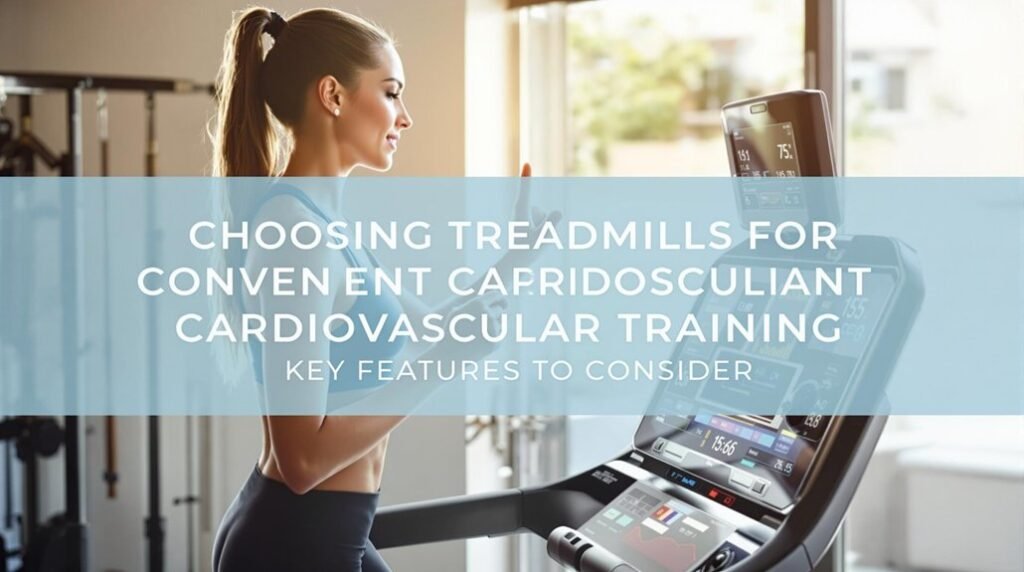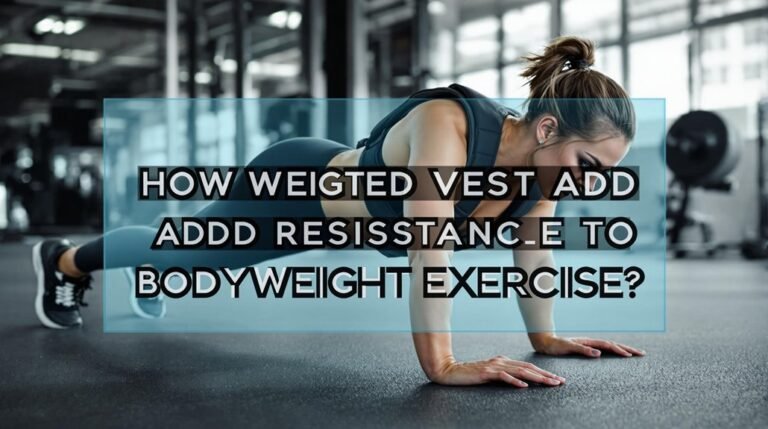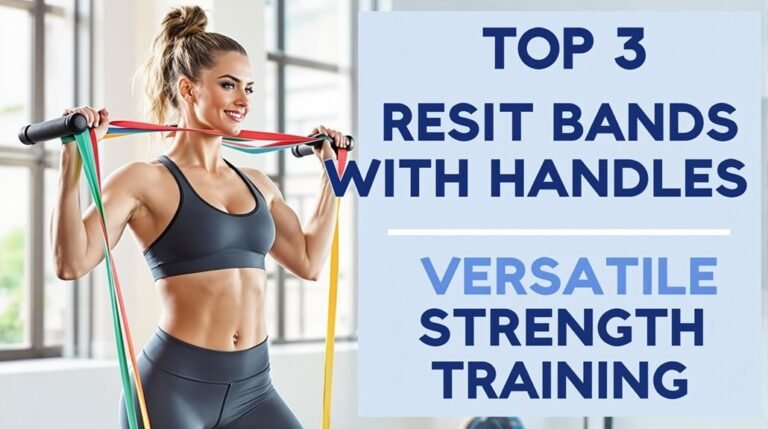When choosing a treadmill for home cardio training, you'll need to evaluate several key features that affect your workout quality. Start by determining the type you need – manual, motorized, or curved – based on your fitness goals and available space. Look for essential features like adjustable incline settings, customizable speed controls, and built-in heart rate monitors to maximize your training effectiveness. You'll want at least 45 square feet of space with proper clearance on all sides for safety. Smart features like pre-programmed workouts and performance tracking help maintain progress, while shock absorption reduces joint impact. Understanding these elements will guide you toward the perfect cardiovascular training solution.
Key Takeaways
- Choose between manual or motorized treadmills based on fitness goals, with motorized options offering more versatility for varied cardio training.
- Look for adjustable incline settings and customizable speed controls to maximize workout intensity and progression options.
- Ensure proper space requirements with minimum two feet clearance on sides and six feet behind for safe operation.
- Select models with heart rate monitoring and pre-programmed workouts to track performance and maintain optimal training zones.
- Consider shock absorption features and emergency shut-off systems to protect joints and ensure safety during extended sessions.
Understanding Treadmill Types
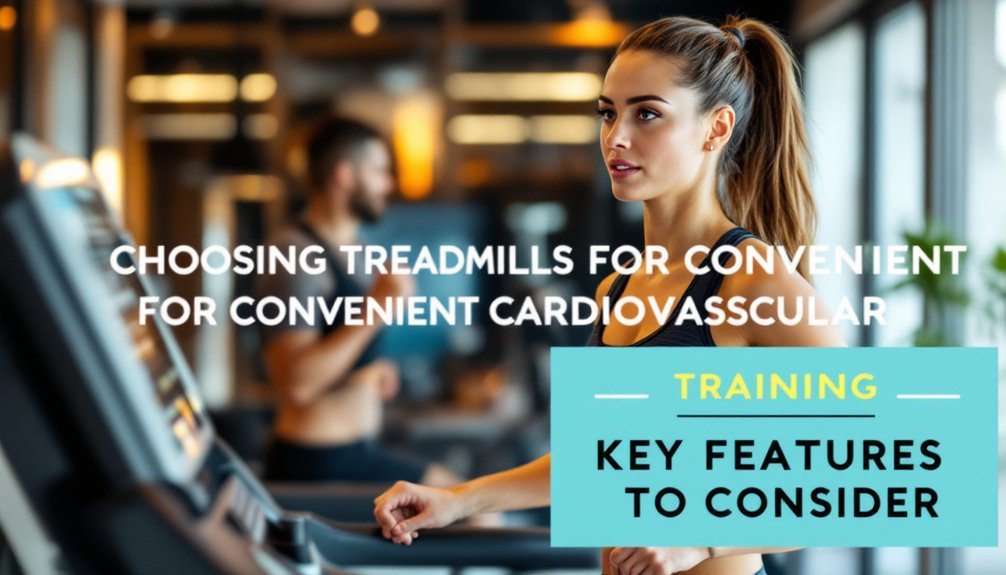
Treadmills come in four main types, each designed for specific fitness needs and living spaces. Your choice should align with your user preferences and available space, while considering treadmill maintenance requirements.
Manual treadmills offer a belt powered by your movement, providing an intense workout without electricity. Motorized models feature adjustable speeds and advanced tracking features, making them ideal for varied training programs. Curved treadmills deliver more intense workouts through their unique design that engages core and leg muscles effectively, similar to how probiotics improve gut health by enhancing intestinal function. If you're dealing with limited space, folding treadmills can be stored vertically when not in use, though you'll need to guarantee proper locking mechanisms for safety. For those wanting to stay active while working, desk treadmills and under-desk options let you walk while completing tasks, though they're limited to lower speeds and don't include traditional handrails or advanced features.
Essential Features for Cardio Training
When selecting a treadmill for cardiovascular exercise, you'll need specific features that support effective training and progress monitoring. Modern treadmill technology offers essential tools like adjustable incline settings, customizable speed controls, and heart rate monitors to help you maximize your workouts. Additionally, investing in essential cardio equipment can significantly enhance your overall fitness experience.
You'll want to focus on features that enhance workout motivation and track your progress. Look for machines with clear display consoles showing real-time metrics of your speed, distance, and heart rate. The treadmill should also include pre-programmed workouts that match your fitness level, whether you're walking, jogging, or running. For comfort and safety, choose a model with adequate shock absorption and a cushioned deck that reduces impact on your joints, especially if you're planning longer training sessions. Quality treadmills can help you burn up to 600 calories per hour during your workout sessions.
Space Planning and Storage

Beyond selecting the right features for your cardio workouts, proper space planning determines whether your treadmill will fit comfortably in your home. For ideal space optimization, you'll need at least two feet of clearance on each side and six feet behind your treadmill for safety. A proper layout will help create a functional exercise environment that supports your fitness goals. The total recommended floor space is 45 square feet minimum. Additionally, investing in compact home gym solutions can enhance your overall workout experience by providing versatile options.
When considering storage solutions, folding treadmills can help maximize your available space. However, you'll still need the same clearance area when the machine is in use. Before purchasing, measure your room's dimensions carefully, including ceiling height if you're planning to use incline features. Remember to account for electrical outlet locations and verify proper ventilation around your equipment. Don't forget to keep the space behind your treadmill clear of obstacles for emergency dismounts.
Training Programs and Customization
Modern training programs and customization features transform your treadmill into a versatile fitness hub. With advanced technology, you'll find extensive libraries of training profiles that adapt to your fitness level, focusing on power, stamina, or speed development through personalized workouts. The purposeful class design ensures every session maximizes your fitness results. Additionally, many treadmills offer essential workout apps that can enhance your fitness experience.
You can customize your experience through interval training, which alternates between high and low intensities to maximize cardiovascular benefits. SmartAdjust technology automatically modifies speed and incline based on your preferences, while real-time feedback guides you through each session. You'll also benefit from trainer integration features, including on-screen guidance and voice coaching, to enhance your workout effectiveness. Performance tracking helps you monitor progress with detailed metrics, while wireless connectivity guarantees seamless interaction with training programs and audio options.
Health Benefits and Safety
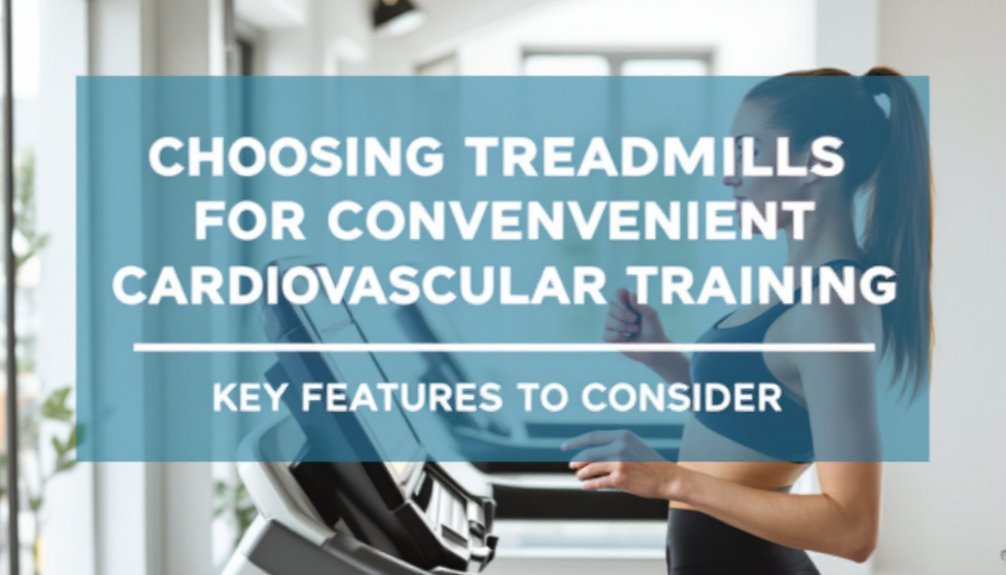
Regular treadmill exercise delivers powerful cardiovascular benefits while offering safety features that protect users during workouts. One of the key treadmill advantages is its thorough impact on heart health, improving circulation and strengthening cardiac muscles. Modern machines include essential safety features to guarantee injury prevention during your fitness journey. For optimal results, aim to get 150 minutes weekly of moderate-intensity exercise on your treadmill. Additionally, regular physical activity can enhance gut health by promoting beneficial bacteria growth in the microbiome.
- Your heart grows stronger with each session as the workout challenges it to pump blood more efficiently.
- You'll notice improved blood pressure and healthier cholesterol levels with consistent use.
- Built-in emergency shut-offs and safety bars protect you from accidents.
- Proper spacing of at least 2 feet on sides and 6 feet behind prevents injuries.
Remember to maintain your treadmill regularly, keeping it clean and well-lubricated for maximum safety and performance.
Frequently Asked Questions
How Long Should I Expect My Treadmill's Motor to Last?
Verily, your treadmill's motor lifespan typically reaches a decade with proper care. You'll extend its life beyond 10 years if you're diligent with maintenance tips like regular cleaning and lubrication.
Can I Use My Treadmill on Carpet Without Damaging It?
You'll need a treadmill mat to guarantee stability and protect your carpet. Low-pile carpets work better, but high-pile can cause instability and damage both your treadmill and carpet.
What's the Average Power Consumption of a Motorized Treadmill?
Your treadmill's power consumption typically ranges from 500-1500 watts, averaging around 700 watts per hour. Motor power ratings and energy efficiency impact your monthly usage of 15-22.5 kilowatt-hours.
How Often Should Professional Maintenance Be Performed on a Treadmill?
You'll need professional treadmill upkeep annually for home models and every 3-6 months for commercial use. Follow your maintenance schedule strictly, especially if you're using it frequently.
Are Treadmill Displays Accurate for Calorie Counting and Distance Measurements?
Your treadmill's display accuracy varies: distance measurements are fairly reliable, but calorie tracking is less accurate as it doesn't account for personal factors like fitness level and muscle mass.

